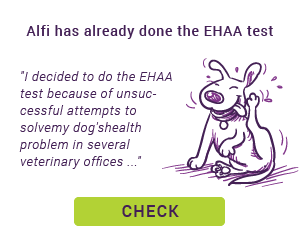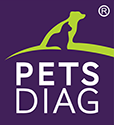Figuring out what to feed puppies is a challenge for every dog owner. In the first six months of life, the dog’s body is intensively developing. That’s why it’s very important to ensure that your puppy receives all necessary nutrients with its food. Any deficiency can result in abnormal growth and health problems in adulthood. What should you pay special attention to?
MAIN INGREDIENTS
After your new puppy arrives, for the first one or two weeks it’s worth feeding it with what it was fed at the puppy farm. This can help avoid diarrhoea caused by the stress of relocation and sudden changes in food. Up to six months of age, meals are divided into 4-5 servings, and then gradually reduced to 2-3 per day, preferably at the same time each day. Food for growing dogs should have high digestibility and biological value. This results in better absorption of the nutrients it contains.
For growing dogs, the caloric content of meals is very important. The energy requirement of puppies is twice that of adult dogs of the same body weight, and depends on age and breed. This is due to the intensive growth and development of the body. This doesn’t mean, however, that feeding on demand should be allowed. Excess calories lead to the proliferation of fat cells, which in later years may result in obesity. Keep in mind that fat is also a source of polyunsaturated fatty acids from the n-3 and n-6 families. They support normal brain development, as well as that of sight and hearing. Therefore, it’s worth including fish oils, e.g. wild salmon oil, in the puppy’s diet.
 The building of new tissues in a growing body also requires good quality protein, i.e. protein with high digestibility and exogenous (essential) amino acid content. It’s worth choosing products of animal origin as the source of this ingredient. The total protein content of the food should be 25g/100g dry basis for puppies up to 14 weeks of age and 20g/100g dry basis after 14 weeks of age.
The building of new tissues in a growing body also requires good quality protein, i.e. protein with high digestibility and exogenous (essential) amino acid content. It’s worth choosing products of animal origin as the source of this ingredient. The total protein content of the food should be 25g/100g dry basis for puppies up to 14 weeks of age and 20g/100g dry basis after 14 weeks of age.
CALCIUM AND PHOSPHORUS
Of all the macro- and microelements, the most important for puppies are calcium and phosphorus, which are involved in the formation of the skeleton of the young pup. Up to about 10 months of age, dogs absorb calcium from the gastrointestinal tract in a passive way. This means that the amount of calcium absorbed is almost the same as its content in the diet. So, an excess of this element in the diet will result in its excess in the body and may contribute to the development of bone and cartilage diseases. This should be borne in mind when deciding to feed your dog complete food. This type of food is properly balanced in terms of all ingredients, and additional supplementation isn’t necessary.
An overdose of calcium is particularly dangerous for large and giant breed dogs. Contrary to popular opinion, increasing the percentage of this element in their diet will not have a positive effect on the growth and structure of the puppy bones – quite the contrary, it may contribute to the slowing of growth, as well as the occurrence of diseases such as hip dysplasia, osteochondrosis (osteochondral necrosis), rickets and nutritional secondary hyperparathyroidism.
The optimal calcium content in the dry basis of food for small and medium breeds is 0.7-1.7%, and for large breeds 0.7-1.2%. The correct ratio of calcium to phosphorus is 1-1.5:1 for large breeds, and 1-1.8:1 for others.
For dogs fed meals prepared at home, a good source of calcium is powdered egg shells, sea algae, calcium citrate or meat and bone meal, which also contain phosphorus.
OTHER MINERALS
You shouldn’t forget about other elements. Puppies have much higher demand for them than adult dogs do. The minimum content of these ingredients is presented in the table.
Table 1 Minimal mineral content in puppy food (FEDIAF, 2019)
| MINERAL |
MINIMUM CONTENT IN FOOD |
|
MACROELEMENTS (g/100g dry basis)
|
| Sodium |
0,22 |
| Potassium |
0,44 |
| Magnesium |
0,04 |
| Chlorine |
0,33 |
|
MICROELEMENTS (mg/100g dry basis)
|
| Iron |
8,80 |
| Zinc |
10,0 |
| Copper |
1,10 |
| Manganese |
0,56 |
| Jodine |
0,15 |
| Selenium |
40,0 |
Insufficient amounts of the above-mentioned macro- and microelements usually result in growth delays. In the case of iron, difficulties also arise with young dogs remembering commands. There’s also microcytic hypochromatic anaemia, which manifests, among other things, in diarrhoea, pallor of mucous membranes, petechiae and tarry stool. In puppies with a potassium deficiency, pelvic limb muscle paralysis and ventral flexion of the neckcan be seen. In dogs with a magnesium deficiency, there are muscle tremors and reduced bone mineralisation. Insufficient sodium concentration in the body is manifested by increased heart rate and thirst. The effects of zinc deficiency are easy to see, and include changes on the skin of the paw pads. Copper deficiency can manifest in discolouration of the coat.
The source of most micro- and macro elements is products of animal origin, particularly meat. In addition, it’s worth including offal (heart, kidney, lung, spleen, liver), which is rich in copper, selenium and iron, as well as fish and crustaceans, which have iodine.
SUMMARY
The first months of a dog’s life are a period of intensive growth and development. During this stage, nutrition plays a key role in the formation of the young body. Any mistakes may result in health problems that will become apparent in the adult life of your pet. That’s why it’s so important to choose the right food for puppies, or in the case of meals prepared by you, to use vitamin and mineral supplements. To make sure that your puppy is growing properly, regular weight checks are recommended. You can also do an EHAA test, which will allow you to see the content of minerals in the dog’s coat, and on this basis balance any deficiencies.
Eng. Zootechnician, Katarzyna Żmuda
 1. Ceregrzyn M., Barszczewska B., Lechowski R. 2016. Podstawy żywienia psów i kotów. Wydawnictwo Edra Urban & Partner. Wrocław.
1. Ceregrzyn M., Barszczewska B., Lechowski R. 2016. Podstawy żywienia psów i kotów. Wydawnictwo Edra Urban & Partner. Wrocław.
2. Dobenecker B. 2002. Influence of calcium and phosphorus intake on the apparent digestibility of these minerals in growing dogs. The Journal of Nutrition, nr 132(6)
3. FEDIAF. 2019. Nutritional Guidelines For Complete and Complementary Pet Food for Cats and Dogs (Wytyczne żywieniowe dotyczące pełnoporcjowych i uzupełniających karm dla kotów i psów). The European Pet Food Industry Federation.
4. Hołda K. 2016. Dodatki żywieniowe w okresie wzrostu. Dog & Sport, nr 2, s. 64-65.
5. Hołda K., Głogowski R. 2016. Żywienie szczeniąt i psów młodych. VetPersonel, nr 2, s. 54-57.
6. Jank M., Wilczak J. 2011. Jak żywić psa. Zdrowa dieta, smakołyki, przygotowanie karmy. Multico Oficyna Wydawnicza. Warszawa.
7. Lauten S. D. 2006. Nutritional Risks to Large-Breed Dogs: From Weaning to the Geriatric Years. Veterinary clinics small animal practice, nr 36, s. 1345-1359.
8. Mirowski A. 2014. Żywieniowe czynniki ryzyka chorób układu kostno-stawowego u szczeniąt psów ras dużych i olbrzymich. Życie weterynaryjne, nr 89(2), s. 125-127.
9. Sygocki C. Minerały i witaminy dla psa potrzebne do utrzymania pełni zdrowia. https://vetexpert.eu/blog/skladniki-mineralne-i-witaminy-czego-potrzebuje-twoj-piesdo-utrzymania-pelni-zdrowia.
10. Wilczak J., Jank M. 2013. Żywienie psów rosnących ras dużych – cz. I. Weterynaria w Praktyce, nr 11-12, s. 78-83.
11. Witkowska O. 2015. Żywienie a behawior psów i kotów. Życie weterynaryjne, nr 90(9), s. 573-576.












